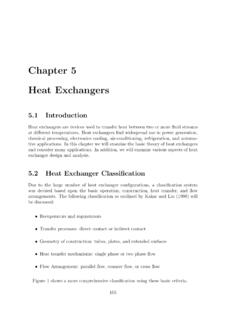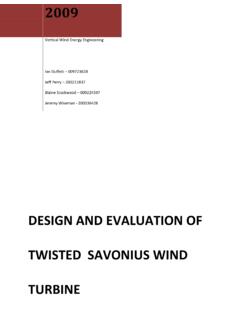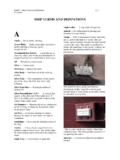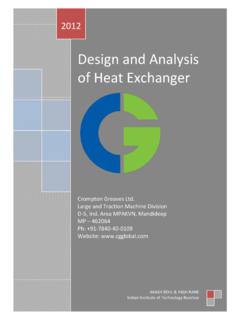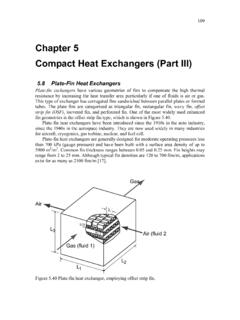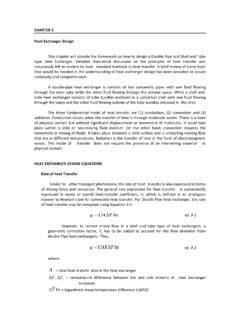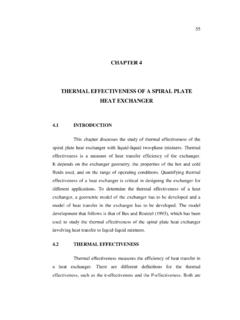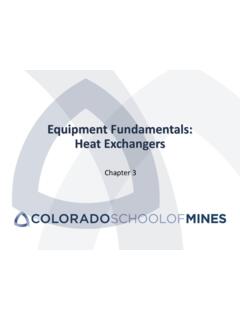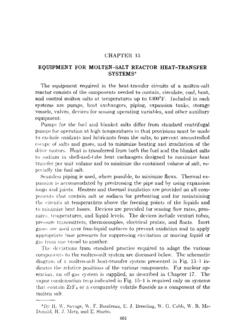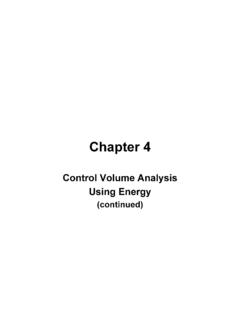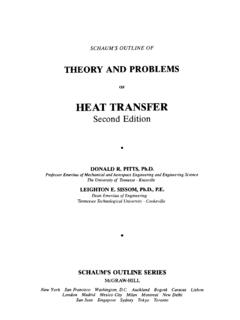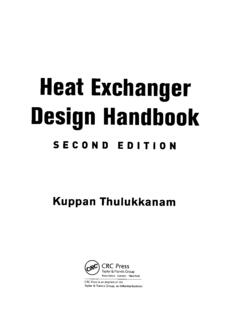Transcription of Chapter 5 Heat Exchangers - engr.mun.ca
1 Chapter 5 heat IntroductionHeat Exchangers are devices used to transfer heat between two ormore fluid streamsat different temperatures. heat Exchangers find widespread use in power generation,chemical processing, electronics cooling, air-conditioning, refrigeration, and automo-tive applications. In this Chapter we will examine the basic theory of heat exchangersand consider many applications. In addition, we will examine various aspects of heatexchanger design and heat exchanger ClassificationDue to the large number of heat exchanger configurations, a classification systemwas devised based upon the basic operation, construction, heat transfer, and flowarrangements. The following classification as outlined by Kakacand Liu (1998) willbe discussed: Recuperators and regenerators Transfer processes: direct contact or indirect contact Geometry of construction: tubes, plates, and extended surfaces heat transfer mechanisms: single phase or two phase flow Flow Arrangement: parallel flow, counter flow, or cross flowFigure 1 shows a more comprehensive classification using these basic Equipment and heat exchanger Design MethodsThe goal of heat exchanger design is to relate the inlet and outlet temperatures,the overall heat transfer coefficient, and the geometry of the heat exchanger , to therate of heat transfer between the two fluids.
2 The two most common heat exchangerdesign problems are those ofratingandsizing. We will limit ourselves to the designof recuperators only. That is, the design of a two fluid heat exchanger used for thepurposes of recovering waste will begin first, by discussing the basic principles of heat transfer for a heatexchanger. We may write the enthalpy balance on either fluid stream to give:Qc= mc(hc2 hc1)( )andQh= mh(hh1 hh2)( )For constant specific heats with no change of phase, we may also writeQc= ( mcp)c(Tc2 Tc1)( )andQh= ( mcp)h(Th1 Th2)( )Now from energy conservation we know thatQc=Qh=Q, and that we may relatethe heat transfer rateQand the overall heat transfer coefficientU, to the some meantemperature difference Tmby means ofQ=U A Tm( )whereAis the total surface area for heat exchange thatUis based upon.
3 Later weshall show that Tm=f(Th1, Th2, Tc1, Tc2)( )It is now clear that the problem of heat exchanger design comesdown to obtainingan expression for the mean temperature difference. Expressions for many flow con-figurations, parallel flow, counter flow, and cross flow, have been obtained in theheat transfer field. We will examine these basic expressions approachesto heat exchanger design that will be discussed are the LMTD method and the effec-tiveness - NTU method. Each of these methods has particular advantages dependingupon the nature of the problem Overall heat Transfer CoefficientA heat exchanger analysis always begins with the determination of the overall heattransfer coefficient. The overall heat transfer coefficient may be defined in terms ofHeat Exchangers73individual thermal resistances of the system.
4 Combining each ofthese resistances inseries gives:1U A=1( ohA)i+1 Skw+1( ohA)o( )where 0is the surface efficiency of inner and outer surfaces,his the heat transfercoefficients for the inner and outer surfaces, andSis a shape factor for the wallseparating the two surface efficiency accounts for the effects of any extended surface which ispresent on either side of the parting wall. It is related to the finefficiency of anextended surface in the following manner: o=(1 (1 f)AfA)( )The thermal resistances include: the inner and outer film resistances, inner andouter extended surface efficiencies, and conduction through a dividing wall whichkeeps the two fluid streams from mixing. The shape factors for a number of usefulwall configurations are given below in Table 1.
5 Additional results will be presentedfor some complex doubly connected ( ) is for clean or unfouled heat exchanger surfaces. The effects offouling on heat exchanger performance is discussed in a later section. Finally, weshould note thatU A=UoAo=UiAi( )however,Uo6=Ui( )Finally, the order of magnitude of the thermal resistances in the defintion of theoverall heat transfer coefficient can have a significant influence onthe calculation ofthe overall heat transfer coefficient. Depending upon the nature of the fluids, oneor more resistances may dominate making additional resistancesunimportant. Forexample, in Table 2 if one of the two fluids is a gas and the other aliquid, then it iseasy to see that the controlling resistance will be that of the gas,assuming that thesurface area on each side is Equipment and SystemsTable 1 - Shape FactorsGeometrySPlane WallAtCylindrical Wall2 Lln(rori)Spherical Wall4 riroro riTable 2 - Order of Magnitude ofhKakac (1991)Fluidh[W/m2K]Gases (natural convection)5-25 Gases (forced convection)10-250 Liquids (non-metal)100-10,000 Liquid Metals5000-250,000 Boiling1000-250,000 Condensation1000-25, LMTD MethodThe log mean temperature difference (LMTD) is derived in all basic heat transfertexts.
6 It may be written for a parallel flow or counterflow arrangement. The LMTDhas the form: TLMT D= T2 T1ln T2 T1( )where T1and T2represent the temperature difference at each end of the heatexchanger, whether parallel flow or counterflow. The LMTD expression assumes thatHeat Exchangers75the overall heat transfer coefficient is constant along the entire flow length of the heatexchanger. If it is not, then an incremental analysis of the heat exchanger is LMTD method is also applicable to crossflow arrangements whenused with thecrossflow correction factor. The heat transfer rate for a crossflow heat exchanger maybe written as:Q=F U A TLMT D( )where the factorFis a correction factor, and the log mean temperature difference isbased upon the counterflow heat exchanger LMTD method assumes that both inlet and outlet temperatures are this is not the case, the solution to a heat exchanger problem becomes some-what tedious.
7 An alternate method based upon heat exchanger effectiveness is moreappropriate for this type of analysis. If T1= T2= T, then the expression forthe LMTD reduces simply to NTU MethodThe effectiveness / number of transfer units (NTU) method was developed to simplifya number of heat exchanger design problems. The heat exchangereffectiveness isdefined as the ratio of the actual heat transfer rate to the maximum possible heattransfer rate if there were infinite surface area. The heat exchanger effectivenessdepends upon whether the hot fluid or cold fluid is a minimum fluid. That is thefluid which has the smaller capacity coefficientC= mCp. If the cold fluid is theminimum fluid then the effectiveness is defined as: =Cmax(TH,in TH,out)Cmin(TH,in TC,in)( )otherwise, if the hot fluid is the minimum fluid, then the effectiveness is defined as: =Cmax(TC,out TC,in)Cmin(TH,in TC,in)( )We may now define the heat tansfer rate as:Q= Cmin(TH,in TC,in)( )It is now possible to develop expressions which relate the heat exchanger efectivenessto another parameter referred to as the nmber of transfer units (NTU).
8 The value ofNTU is defined as:N T U=U ACmin( )It is now a simple matter to solve a heat exchanger problem when76 Mechanical Equipment and Systems =f(N T U, Cr)( )whereCr= expressions have been obtained which relate the heat exchanger effec-tiveness to the number of transfer units. The handout summarizesa number of thesesolutions and the special cases which may be derived from convenience the N T Urelationships are given for a simple double pipe heatexchanger for parallel flow and counter flow:Parallel Flow =1 exp[ N T U(1 +Cr)]1 +Cr( )orN T U= ln[1 (1 +Cr)]1 +Cr( )Counter Flow =1 exp[ N T U(1 Cr)]1 +Crexp[ N T U(1 Cr)], Cr<1( )and =N T U1 +N T U, Cr= 1( )orN T U=1Cr 1ln( 1 Cr 1), Cr<1( )andN T U= 1 , Cr= 1( )For other configurations, the student is referred to the heat Transfer course text, orthe handout.
9 Often manufacturer s choose to present heat exchanger performance interms of the inlet temperature differenceIT D= (Th,i Tc,i). This is usually achievedby plotting the normalized parameterQ/IT D=Q/(Th,i Tc,i). This is a directconsequence of the N T heat exchanger Pressure DropPressure drop in heat Exchangers is an important considerationduring the designstage. Since fluid circulation requires some form of pump or fan,additional costsare incurred as a result of poor design. Pressure drop calculations are required forboth fluid streams, and in most cases flow consists of either two internal streams oran internal and external stream. Pressure drop is affected by a number of factors,namely the type of flow (laminar or turbulent) and the passage Exchangers77 First, a fluid experiences an entrance loss as it enters the heat exchanger core due toa sudden reduction in flow area, then the core itself contributesa loss due to frictionand other internal losses, and finally as the fluid exits the core it experiences a lossdue to a sudden expansion.
10 In addition, if the density changes through the core asa result of heating or cooling an accelaration or decelaration in flow is also contributes to the overall pressure drop (or gain). Allof these effects arediscussed LossThe entrance loss for an abrupt contraction may be obtained byconsidering Bernoulli sequation with a loss coefficient combined with mass conservation to obtain: pi=(1 2i+Kc)12G2 i( )where is the passage contraction ratio andG= m/A, the mass flux of fluid. Ingeneral, =minimum flow areafrontal area( )Core LossIn the core, we may write the pressure drop in terms of theFanningfriction factor: pc=4f LDh12G2 m( )Since the fluid density may change appreciably in gas flows, acceleration or decel-eration may occur. We consider a momentum balance across the core paAc= m(Ve Vi)( )which may be written as pa=G2(1 e 1 i)( )after writingV=G/ , sinceGi= LossFinally, as the flow exits the core, the fluid may pass through a sudden of Bernoulli s equation with mass conservation results in pe= (1 2e Ke)12G2 e( )78 Mechanical Equipment and Systemswhere we have assumed that pressure drop (rise) is from left to right.
